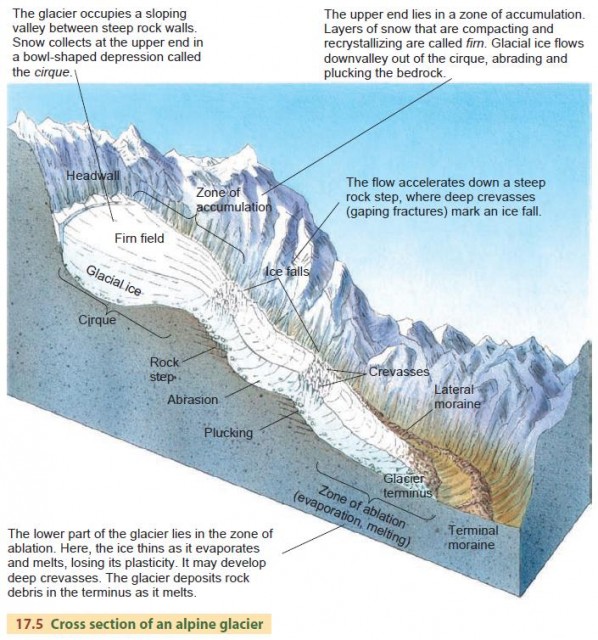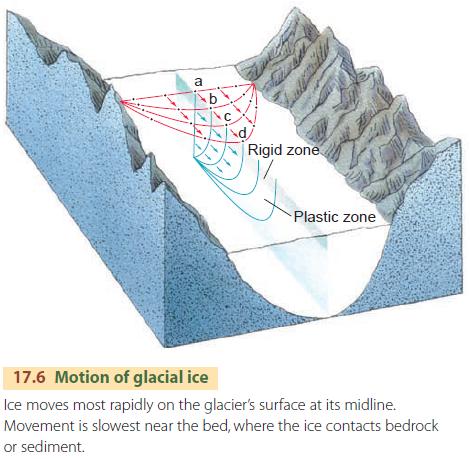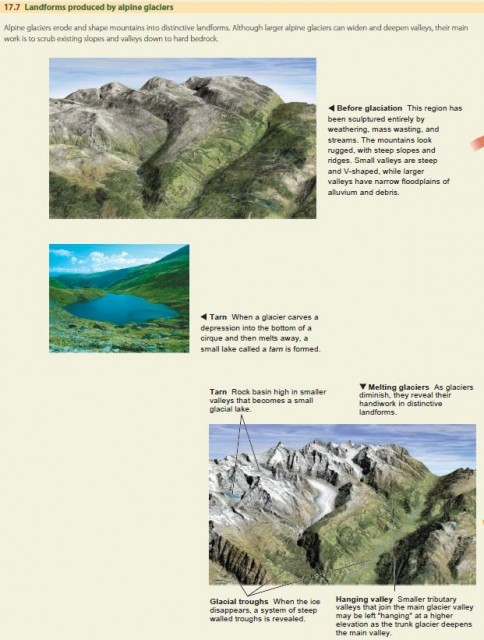Alpine Glaciers
Figure 17.5 shows a cross section of an alpine glacier, illustrating a number of features. The glacier forms in a cirque—a high rock basin in which snow accumulates for year after year until it forms a glacier. Although the uppermost layer of a glacier is brittle, the ice beneath behaves as a plastic substance that flows slowly (Figure 17.6). An alpine glacier can also slide downhill, lubricated by meltwater and mud at its base.
A glacier has a dynamic balance in which the rate of snow accumulation at the upper end balances the rate of evaporation and melting at the lower end. But this balance is easily upset by changes in the average annual rates of snowfall or evaporation and melting, causing the glacier's terminus to advance or retreat.

Glacial flow is usually very slow. It amounts to a few centimeters per day for large ice sheets and the more sluggish alpine glaciers, but can be as fast as several meters per day for an active alpine glacier. However, some alpine glaciers experience episodes of very rapid movement, known as surges. A surging glacier may travel downvalley at speeds of more than 60 m (about 200 ft) per day for several months.
We don't fully understand the reasons for surging, but it probably involves mechanisms that increase the amount of meltwater beneath the ice, enhancing sliding. Most glaciers do not surge.

LANDFORMS MADE BY ALPINE GLACIERS
Figure 17.7 shows how alpine glaciers erode mountain masses to create landforms such as aretes, horns, cols, moraines, tarns, hanging valleys, and glacial troughs. Flowing down mountain slopes and valleys from areas of snow accumulation at high elevations, the ice scrapes loose soil and regolith from the slopes and scoops alluvium out of the valleys. Glacial abrasion smoothes the bed of the glacier and erodes projecting rock masses.
When the ice melts, a system of steep-walled glacial troughs is revealed. The floors of these valleys are normally covered with alluvium, carried by meltwater streams from the receding ice fronts. Tributary glaciers also produce troughs, but they are smaller in cross section and less deeply eroded by their smaller glaciers. Sometimes the floors of these troughs lie well above the level of the main trough, producing hanging valleys. When streams later occupy these abandoned valleys, they create scenic waterfalls and rapids that cascade down steep slopes to the main trough below. Major troughs sometimes hold large, elongated trough lakes.
When the floor of a trough open to the sea lies below sea level, the sea water enters as the ice front recedes, creating a fiord. Fiords are opening up today along the Alaskan coast, where some glaciers are melting back rapidly and ocean waters are filling their troughs. Fiords are found largely along mountainous coasts between lat. 50° and 70° N and S.

